Photography by Jason Spafford
Three years ago, when we installed the first generation (2017) SkyCamp 4X (the original four-berth) upon White Rhino, our 2015 Toyota Hilux, little did we know where the rig would see us make camp—certainly when compared to where we had set our sights. The Cape to Cape plan kick-started well on English soil. Including 10 spectacular weeks in Iceland during the onset of winter, we traversed the Nordics for six months up to one of Europe’s northernmost points: Nordkapp in Northern Norway.
Shortly after, having sent White Rhino packing down the Atlantic to South Africa, we swapped out the warm layers for the lightweight ones. Admittedly, the rooftop tent (RTT) was supposed to spend the majority of its time basking in hotter climes, keep us elevated from the ground-dwelling beasties courtesy of Africa’s diverse fauna, and afford us some of the finest views the continent has to offer. Alas, circumstances forced us to bring our rig back to base when the pandemic hit; an experience we chalked down to Stuff happens, right?
After hundreds of nights sleeping in the SkyCamp 4X, we find ourselves inhabiting iKamper’s latest 2019 iteration, the 2.0, with the Annex S for additional living space as we explore the island wildernesses off northern Scotland.
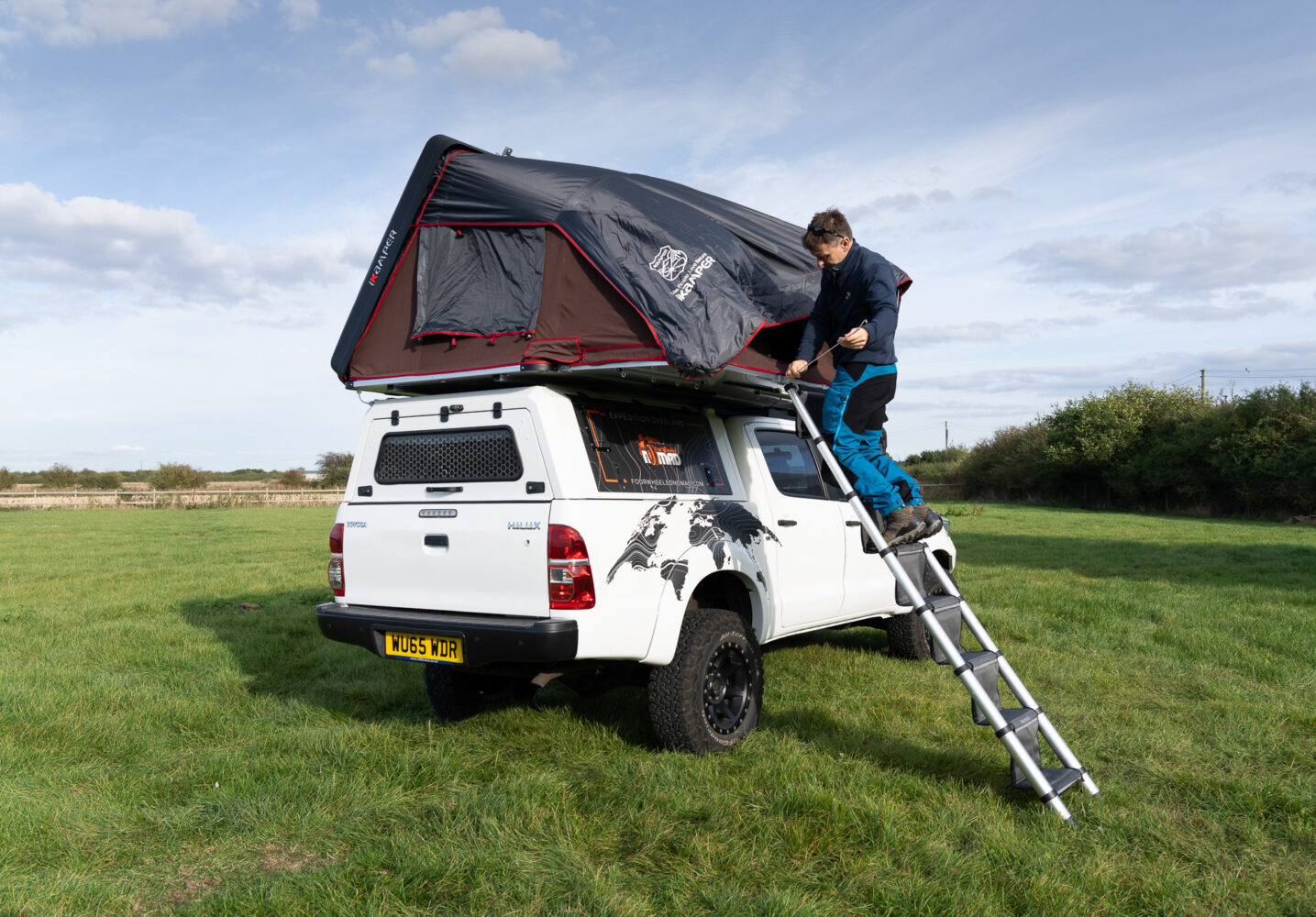
Consistent Features on the 4X and 2.0
Aerodynamically designed with a universal mounting system, most vehicles can accommodate an iKamper rooftop tent, exactly where the appeal lies in this sleek product. Customisable, the weight-conscious shell comes in white, high-gloss black, or rocky (matte) black.
Setup and Sleeping
Gloriously, one of the chief reasons we sought out the SkyCamp was the easy-pop, one-minute setup and pack-up times. Much like the popability of the 4X’s hard shell, once unlocked, the tent gently flips up upon opening, and the collapsible ladder pulls out to support the hinged floor. Namely, an expandable real estate beyond one’s vehicle roof dimensions unfolds to sleep three adults or two adults and two children on a king-size memory foam mattress. Two adults and two young teens could be somewhat of a squeeze. However, as there are only two of us, it’s positively roomy—we spread ourselves out and all our gear. Some sellers claim you can leave your bedding in while the tent is stowed away; we can’t as it’s too bulky. After hooking in the detachable metal rods to prop up the awning above the front door, we’re all set.
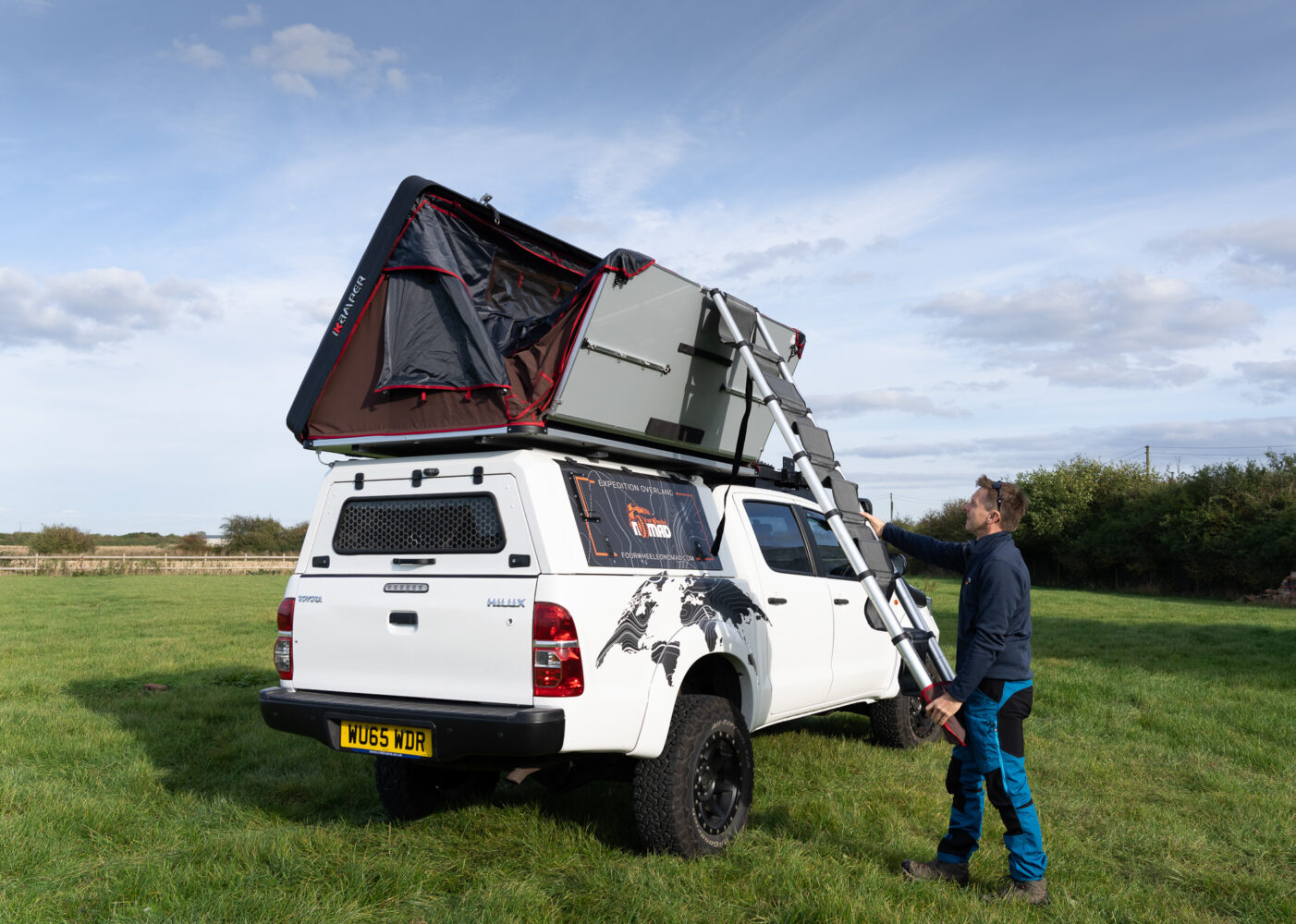
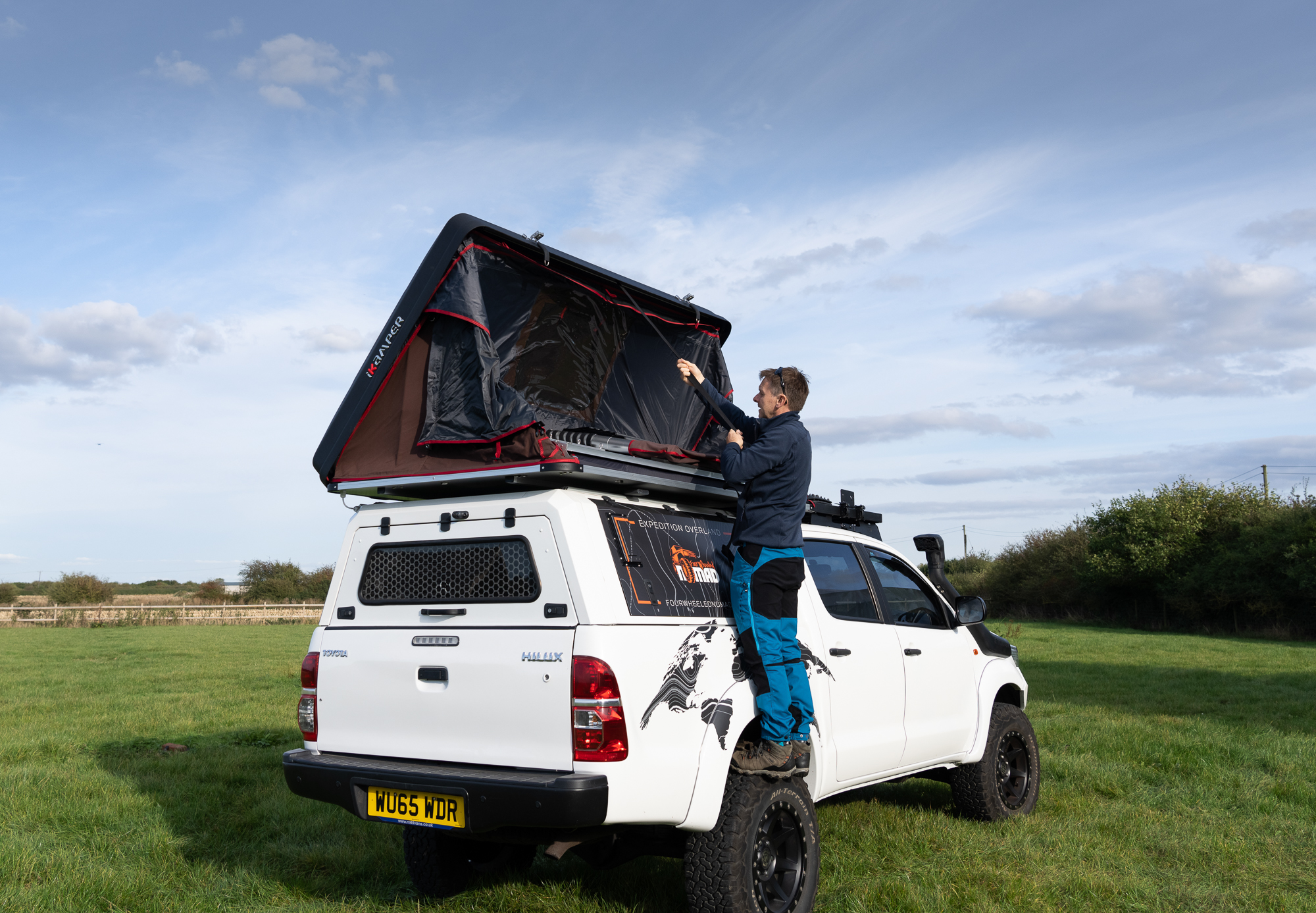

Materials
The same insulating honeycomb aluminium panels comprise the floor, as does the double-wall fibreglass shell with a 1-inch air insulation cavity to keep you toasty on cooler days and comfortable on the scorching ones. The thick (300 grams per square meter) but lightweight poly-cotton canvas is just as breathable to minimise condensation. It is water- and UV-resistant, insulating, durable, and fire retardant. That said, any decent downpour or condensation that does build still requires you to dry it out. The waterproof zippers continue throughout the tent below a 150D (3,000-millimetre hydrostatic head rating) waterproof-coated polyester rainfly with a star-gazing skylight on top. The skyview window has a blackout blind too, which is priceless when you’re after total darkness.
Gratefully, each side window still comes with three layers. A polyester blackout blind, a mesh panel to aid ventilation (keeping out bigger bugs, although these won’t keep out Scotland’s tiny midges), and a plastic window. The plastic window is critical to those of us in wetter climes as it permits light to flood in when it’s pouring down during daytime hours. Indeed, it would be a crying shame if these were to be discontinued on future models. The skylight and entrance also have mesh panels and a canvas panel to keep in the warmth or block out the light.
Overall, there’s the same quality in construction to the 160-pound, 4-season rooftop tent that existed in the first crowd-funded iteration to the many configurations, which led to the 2.0 on the market today. Firsthand experience of utilising the angled hard-shell in the windy Faroe Islands alone has shown us that the design, development, and manufacturing were certified to ISO 9001 for a good reason.
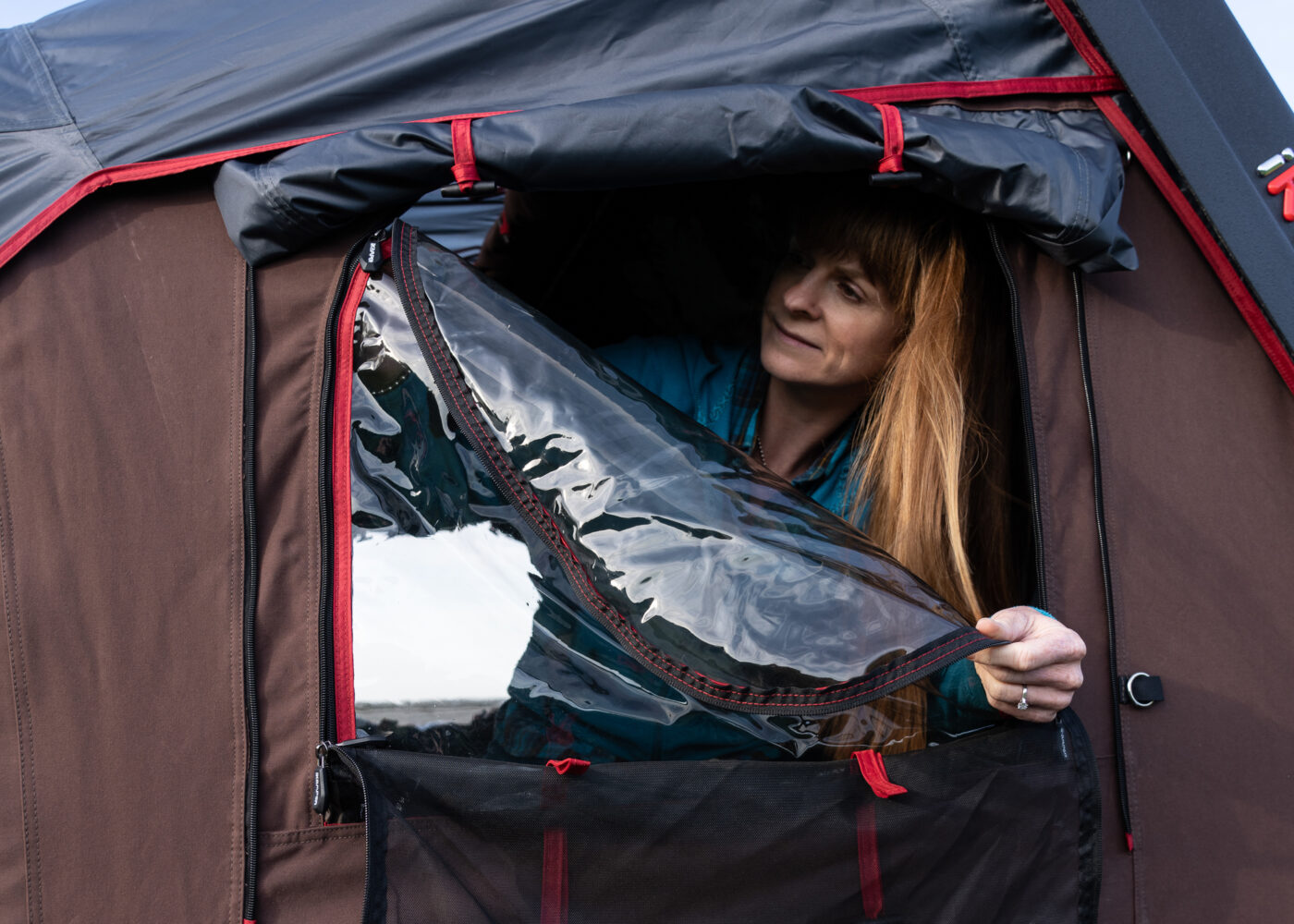
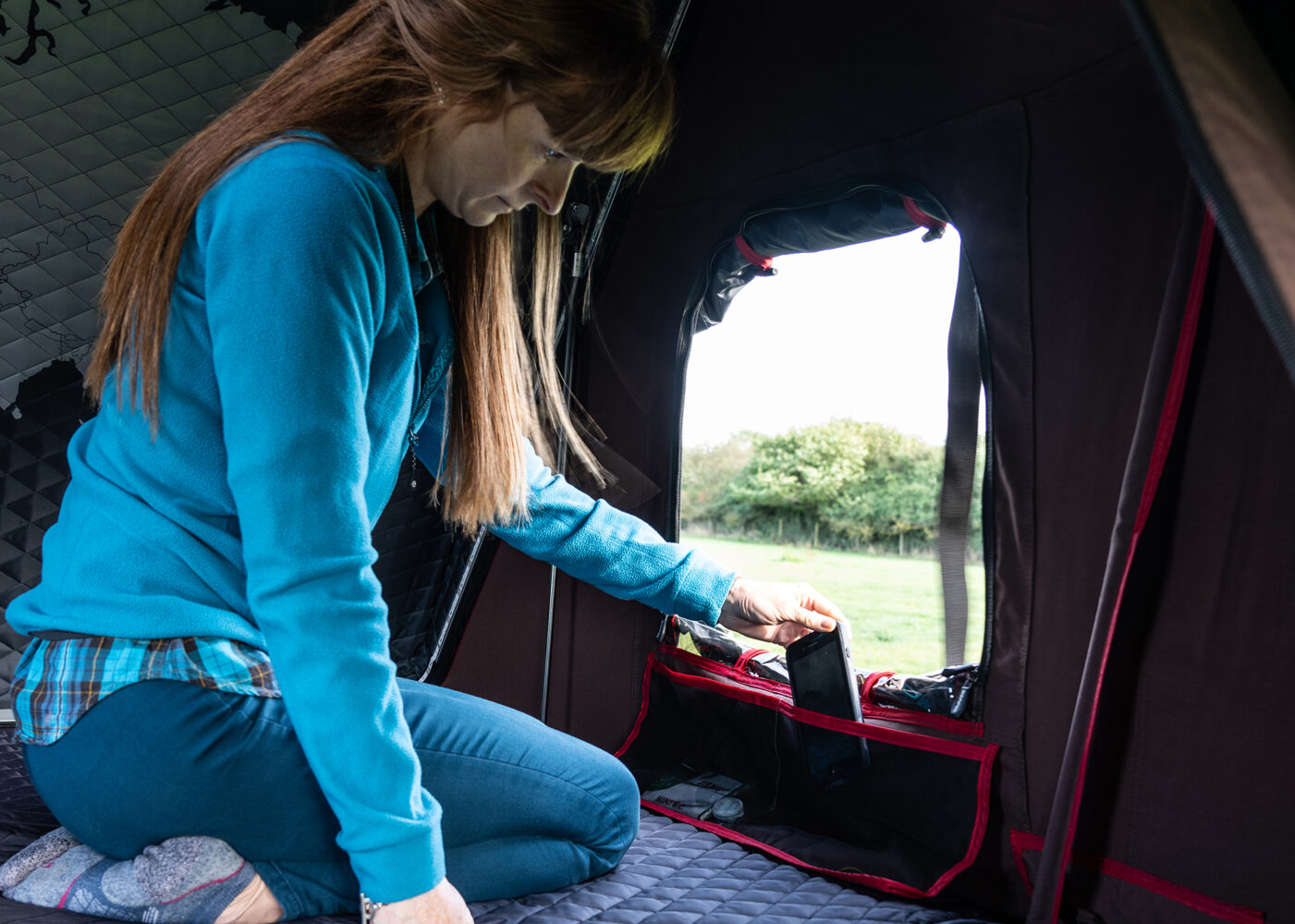
–
Latest Shell
Having opted for the matte-finish Rocky Black fibreglass shell, it has a streamlined ruggedness, which reduces wind noise in transit—always better on fuel economy. It feels more robust, so it performs admirably in the wind (the tent is tested in winds up to 40 mph). This is due to Line-X, a hard-wearing, spray-on protective coating seen on utility vehicles and bed liners of trucks, for instance. The rough-to-the-touch finish will invariably protect the rooftop tent from UV exposure, getting badly scratched, and possible damage during off-road manoeuvring when there’s overhead brush. The two-layer shell construction aids the management of interior condensation. It better insulates during those cooler temperatures—an agreeably tough solution for the overland, off-road seeking, and dispersed camping communities.
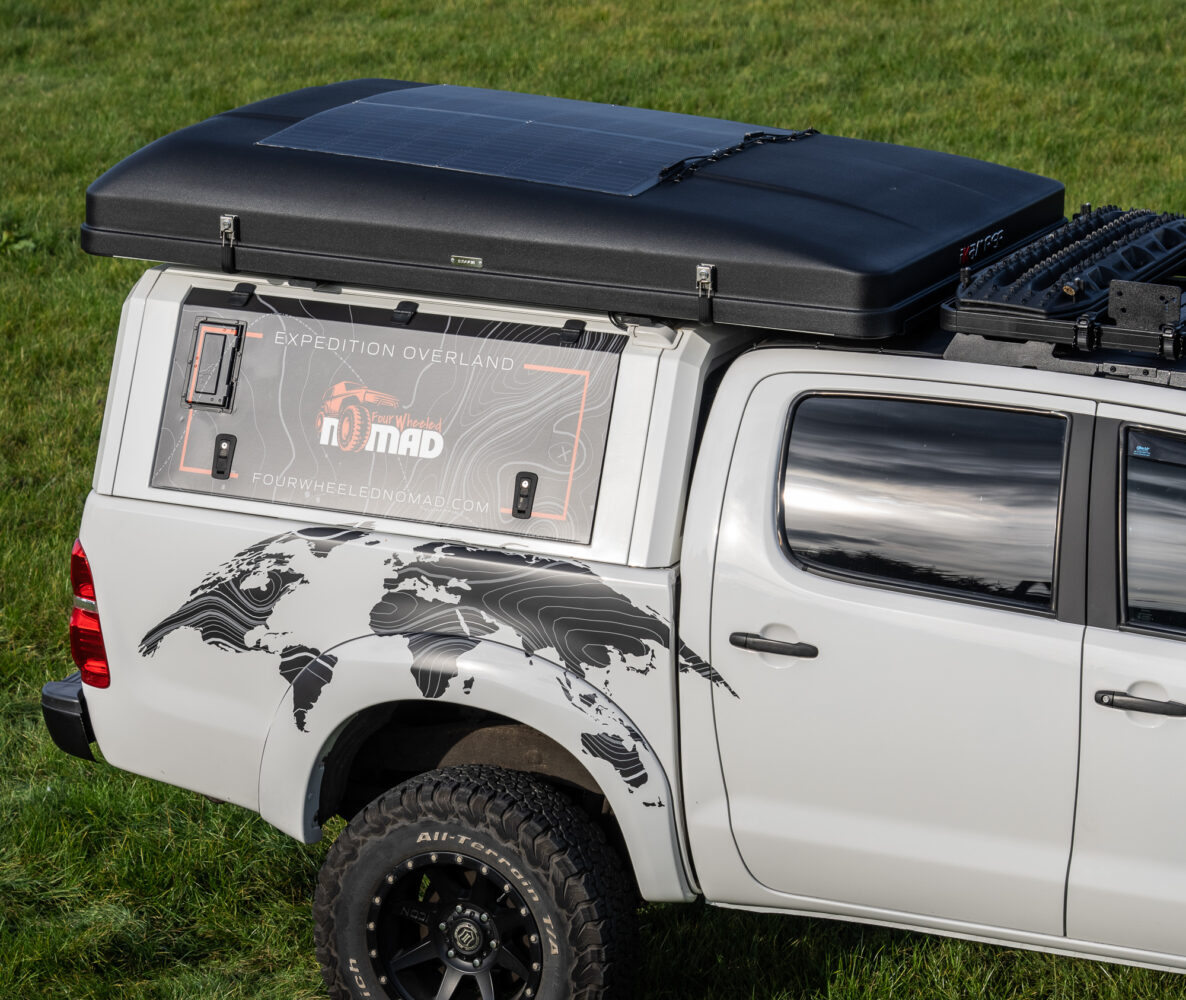
Refinements on the 2.0
It’s clear that iKamper has listened to its growing customer base, learned lessons inside the two-year warranty period around some niggling issues, and enacted quite a few changes to leave the latest 2.0 model feeling markedly improved.
Exterior Features
Firstly, one of the winning upgrades for me is a redesigned, more practical telescopic ladder. It unfolds with flatter steps for increased safety and comfort. Indeed, it’s distinctly nicer underfoot without footwear on while ascending, descending, or stationery. It’s also worth mentioning the welcome addition of straps that self-tuck in any overhanging fabric as the lid eases to a close on the gas struts.
From a security perspective, the hard shell locks are constructed from stronger stainless steel, and the mounting brackets are even easier to install than those on the 4X. Four new metal rods mean you can create a canopy to offer protection from the scorching sun or driving rain outside each window.
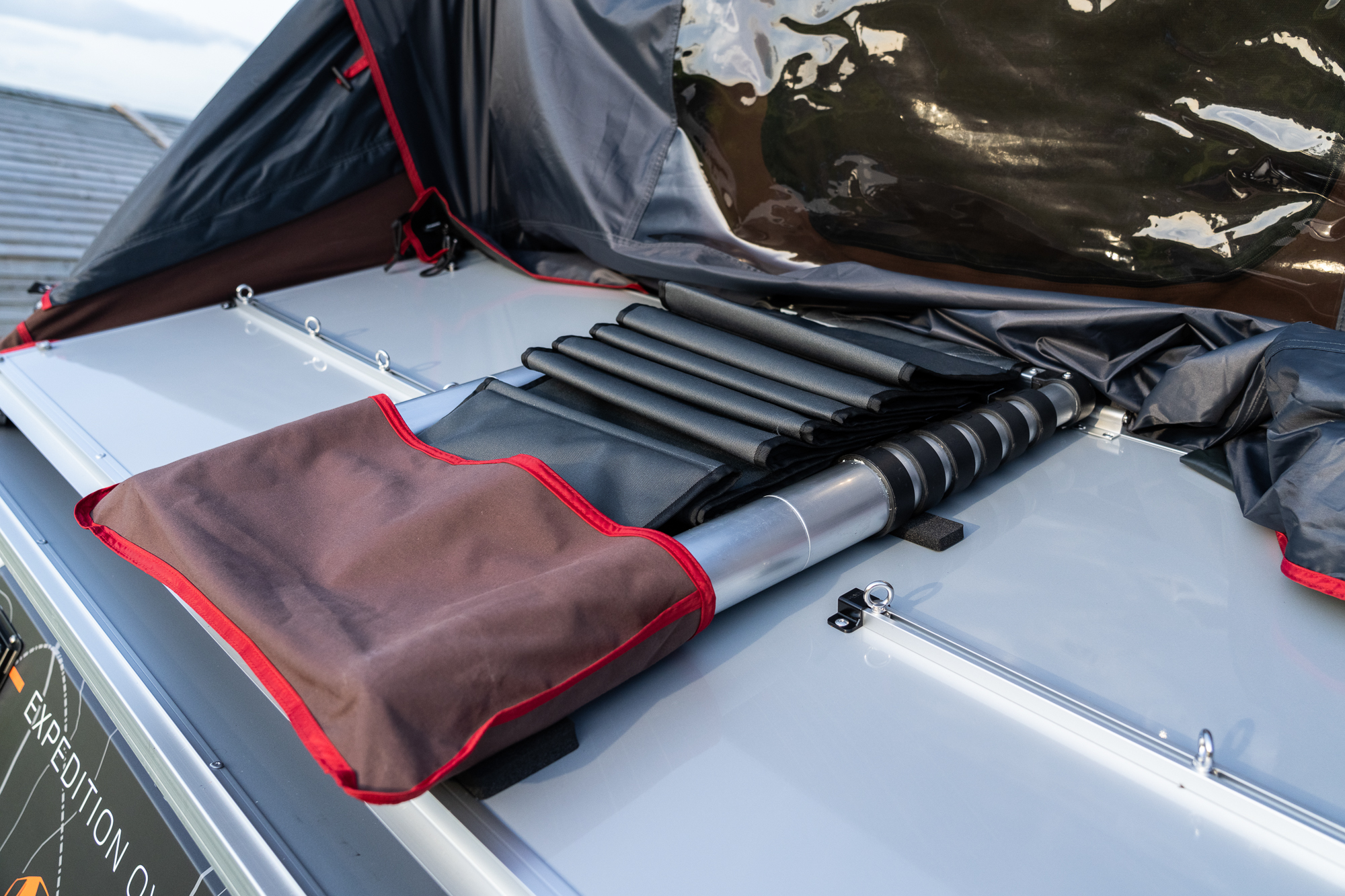
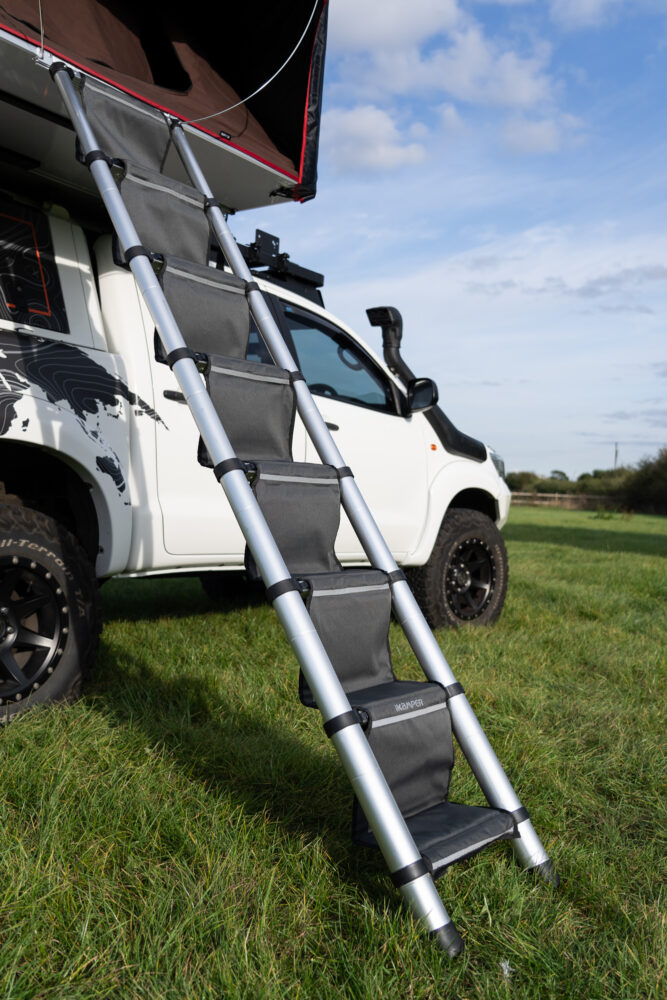
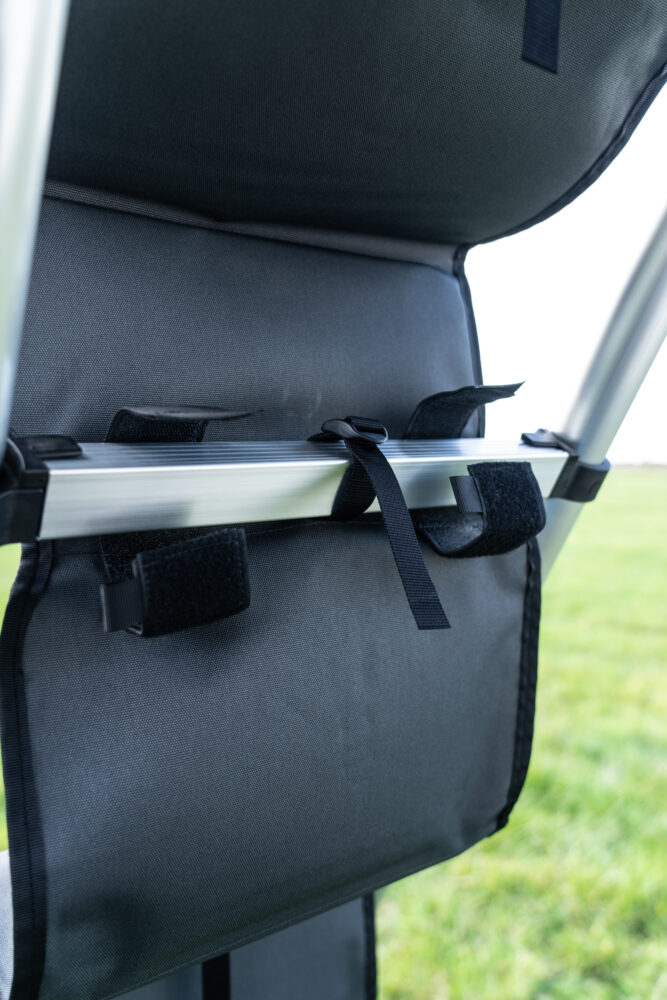
Interior Features
Next up, this RTT version comes with a more practical two-piece mattress covering the entire floor space, which is easy to lob out of the tent to dry out when condensation builds. At 50 percent thicker, it feels twice as deep at 1.8 inches of high-density memory foam and a tad firmer; it’s helpful for anyone with back problems or a preference for side-sleeping. To me, it feels more like a real bed.
Aesthetically, there is a rather cool world map featured across the inside quilted wall. What’s more, there is smart red trim running throughout the canvas to accent the exterior and interior, which extends to the additional fabric hiding part of the supporting stainless steel bar. On another note, built-in mesh storage pockets on both sides of the tent now come as standard, rather than an add-on accessory—convenient for sunglasses, head torches, small devices, etc.
I can’t say any of these improvements are unnecessary ways to justify the premium cost as they all add value in one way or another, including a full two-year warranty plus a three-year limited one. Ultimately, we have yet to encounter a better traditional soft-shell rooftop tent which throws out oodles of space and stows compactly. It’s comfy and stylish throughout, and if you look after it, the SkyCamp 2.0 is set to last you for years, taking some of the sting out of the price tag.
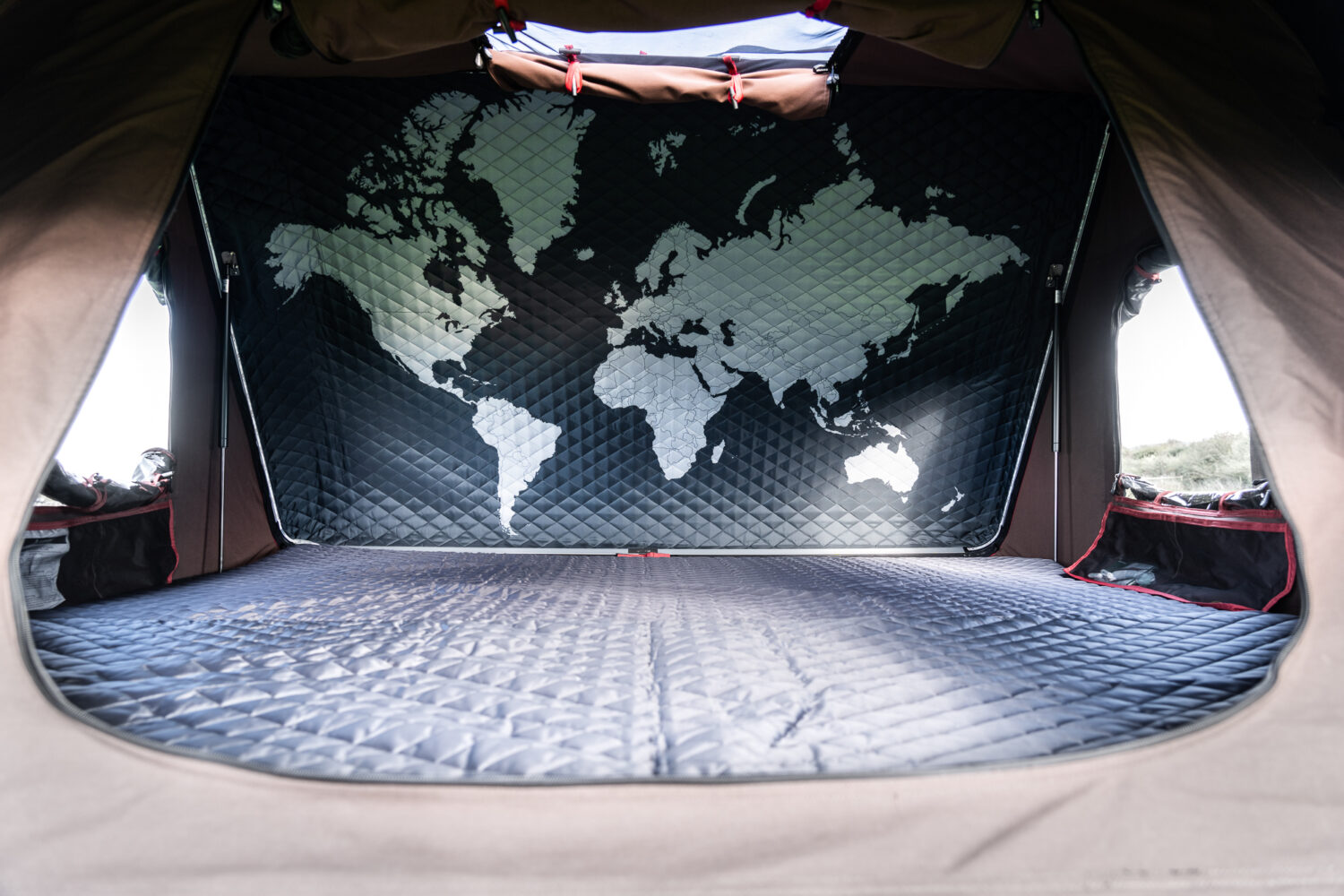
Pros
- Lightweight yet durable with a premium feel
- Aerodynamic design
- Simple setup or stow within 60 seconds
- Big interior for a traditional soft-shell tent
- Universal mounting brackets
- Stows down into a streamlined roof pack
Cons
- Pricey
- Initial mounting can take some time
Annex S
Compatible with the SkyCamp 4X and SkyCamp 2.0, this teepee-style-annex-come-awning has revolutionised our camping in the UK’s cold, wet and windy conditions. A painless zip and peg affair to the SkyCamp’s main entrance and ground respectively makes the lightweight Annex swift and straightforward to assemble. It boasts two large doors to ease entry and exit and three mesh windows to let in the light and manage any condensation.
Conveniently, it’s a roomy space to set up our stall, including a table for four, three Front Runner Wolf Pack boxes, two chairs, and us pair. Moreover, it’s a protective shelter to take refuge from the deluge. When it rains in Scotland, you know about it. Happy as a pig in muck, I can even cook inside and essentially carry on as I would outside.
Perhaps one of the best features is the redundancy of poles; the Annex S can be assembled in two shakes of a lamb’s tail by pegging down the walls. In other words, it’s effortless.

Annex S’s Awning Conversion
Converting to an awning requires additional poles and stakes on the guy lines. Due to the nature of the fabric’s shape, it’s easy to adjust the awning and better protect its inhabitants from the scorching sunshine, driving rain, or chilly wind. It takes the comfort levels through the roof and makes all the regular camping activities such as cooking, playing cards, and putting the kettle on seamless endeavours. The tops of the poles and guy lines can also be utilised to hang wet gear on to dry out.
My only two minor complaints are that the plastic for the large half-moon window doesn’t come as standard; for those in wetter climes, this would have been an excellent feature. At least the mesh ventilates the Annex space and keeps out the insects. The second is that the main sloping wall of the Annex could ideally have featured a guy line just below the window to open the living space just a tad more.
As multi-purpose shelters go, we constantly rotate between pegging it out as a fabulous cocooned addition to our living space or converting it to the awning to enjoy with friends. Hang some fairy lights up, and you’ll take it to the next level of glamping. It is an impressive addition to the SkyCamp 2.0. In fact, it’s one of our best additions to our overlanding arsenal. I absolutely love it and wouldn’t swap this for iKamper’s bigger awning.
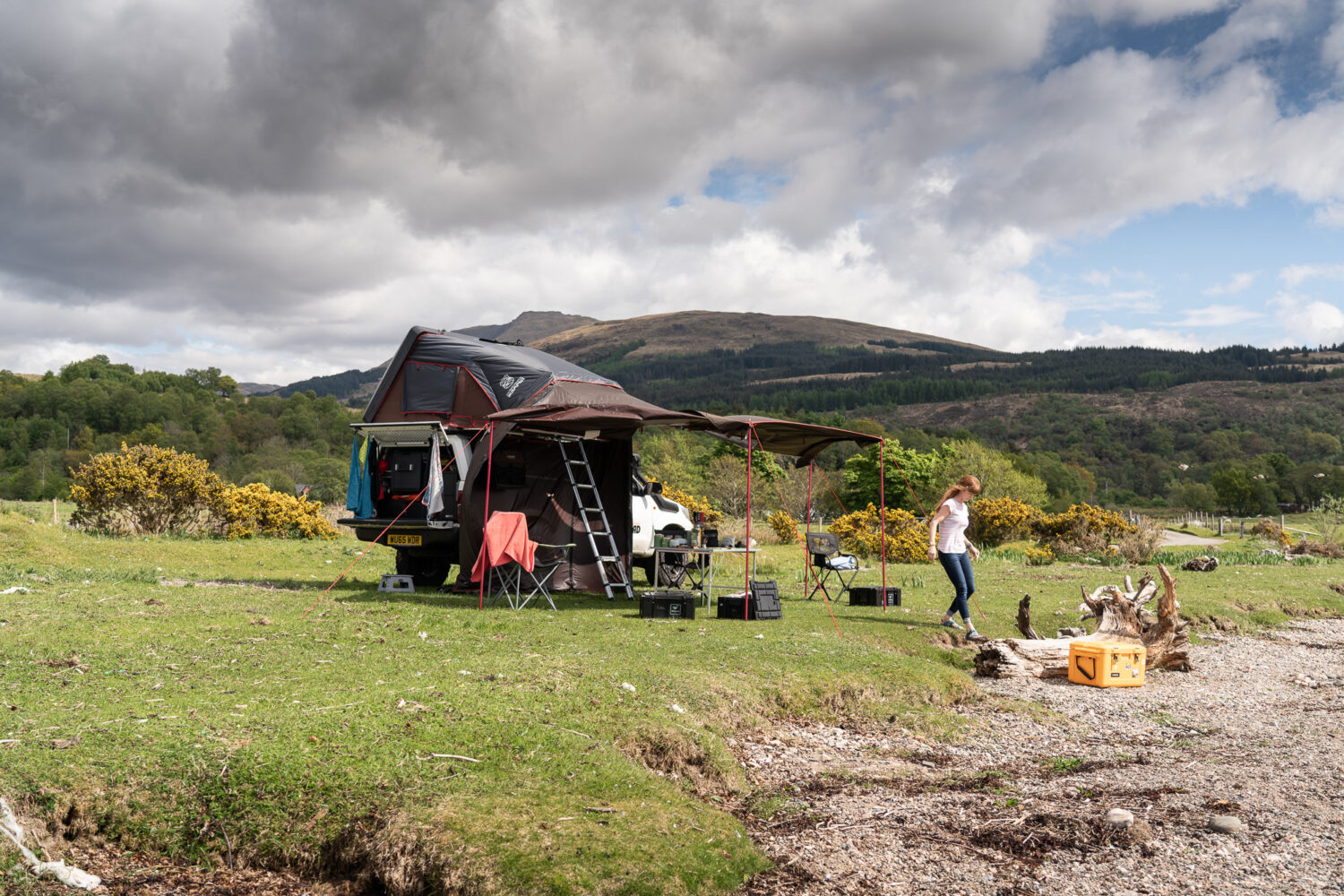
Pros
- Versatile dual-purpose shelter
- Lightweight
- Same quality waterproof fabric as the SkyCamp 2.0’s rainfly
- Easy, quick setup and stowing
- Compatible with most vehicles with roof racks up to 82 inches
Cons
- Two sets of poles are required, sold separately
- Plastic half moon window is sold separately.
HC Ladder Steps (not yet available in the US)
The HC (High Comfort) ladder steps take glamping from good to great. What I initially thought was perhaps an unnecessary nice-to-have has become an essential accessory to my SkyCamp ensemble. At 1000-millimetre UV/PU coated 900 Denier fabric, every step up and down the ladder has become soft, plush, and extremely comfortable. Undeniably, it makes entry to and exit from the rooftop tent infinitely safer, whether you’ve got excitable little kids that run wild in socks, have enjoyed one too many glasses of your favourite tipple, require any special needs, or relish the peace of mind of being safer with a more secure footing up and down camping ladders.
The straightforward attachment of the HC steps to the telescopic ladder is secured with Velcro, two fasteners, and a buckle to tighten at each step. There are also high-vis reflective accents on each step to guide you up and down when light levels are low.
Perhaps the best aspect of all is the fact you can “set it and forget it.” Namely, when it’s time to break camp, you can retract the ladder with the HC steps in place. Just fold the steps so they poke out through the front of the ladder before retracting the ladder and folding the panel over. This is so the “back” of the ladder still sits flush on the panel when it’s folded over before pulling the shell lid down. Undeniably, this anti-slip accessory gives your feet a noticeably more functional surface area; it’s a stairway to heaven.

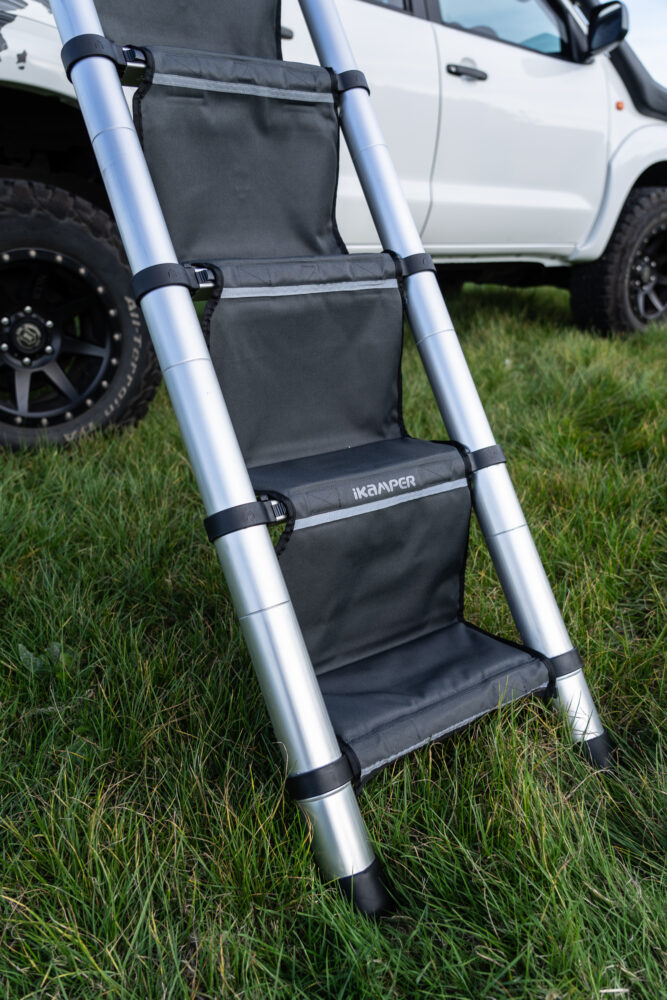
Pros
- Lightweight at 3 kilograms
- Set it and forget it
- Increases every user’s safety
Cons
- You’ll get wet socks when it rains on the steps (go barefoot).
Check out ikamper.com for full product details.
Our No Compromise Clause: We carefully screen all contributors to make sure they are independent and impartial. We never have and never will accept advertorial, and we do not allow advertising to influence our product or destination.


